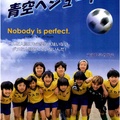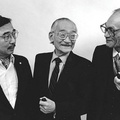Read Part 1 >>
4) Going Online: On that note, resources must be diverted into developing the online business, including building the requisite online infrastructure and hiring online news editors and staffers. That is because online is where journalism is going. Even the publisher of the New York Times was quoted last year as saying, “We will stop printing the New York Times sometime in the future, date TBD.”
As strong as The Rafu Shimpo brand might be in Los Angeles, it makes less sense the further away from L.A. one is. What is needed is a separate online brand with a different name that is nevertheless affiliated and powered by The Rafu Shimpo, leveraging that brand name and extant resources however possible. For instance, since there already is a circulation department, it’s just a matter of adding to the task list the maintenance of online subscriptions.
By going national and online, I have to believe that there are 50,000 potential subscribers scattered along the coasts and interior of this country that could be amassed from the roughly 800,000 Japanese Americans nationwide, especially if the online subscription price was much less expensive. An annual print subscription to The Rafu Shimpo is $149. An annual online subscription could be $75 or $50 or even $30 (discounts could be given to people who can prove membership in a Japanese American church or nonprofit organization). Which is better, $149 times 11,000 paid subscribers or $50 times 50,000 paid subscribers? The latter, not just because of an increase in revenue but because advertisers would find reaching 50,000 subscribers more enticing. In one family, there might be one main account holder and three more subaccount holders, with additional family members (and logins) allowed for a nominal, extra fee. So, a family of four that might have one subscription to the paper could instead be counted as four subscribers, not just one.
Living in Los Angeles and along the West Coast for that matter, we take so many things for granted. Availability of Japanese food and restaurants. Community organizations and events. Dissemination of news affecting our community. It’s different for Japanese American people outside this territory, though. Being online means being connected to that greater community, even if you’re living in Whitefish, Montana.
Part of the website’s infrastructure, however, must be a means by which paid subscribers can post their own news and calendar info, along with photos and video. It’s called community journalism and it’s not far-fetched in this age when so many people now have the necessary tools—a computer with a word processing program, Internet access and a digital camera, as well as a nonanonymous username and password—to document and share their local scholarship dinner, officer installation lunch, or odori recital. A subscriber in Ft. Lupton, Colorado, could, with the limited admin capabilities granted for being a paid subscriber, use a news-loading template built into the content management system and upload a story and photos of an event that took place there. Once submitted, a copy editor would check it and publish it. Suddenly, news that might otherwise be overlooked is submitted and shared. Everyone wins.
Another advantage of going online: Youth. The existing Rafu Shimpo subscriber base is elderly, and with age comes mortality. Also, older people tend to prefer newsprint, which I cannot dispute. I love reading a newsprint newspaper, too, but it’s inevitably going the way of the eight-track tape. Those between the ages of 25-55, however, not only have many more years to go, they are more likely to be computer users with Web access, either at home or at work. THAT is the audience to reach. Not only that, this demographic slice of the community is the group that is most likely to own or consider owning an iPad or other tablet computer, a product that was nonexistent a year ago but has exploded in popularity—and still has not reached its full market potential to deliver digital content.
Growing that online subscriber base is very important from an advertiser’s point of view. It’s in the numbers, because reaching 11,000 readers doesn’t excite an advertiser as much as reaching 50,000, 60,000 or 100,000 readers.
Now, here’s the real kicker: Keep news of interest to the Japanese American community the main reason for people to visit the website, the tentpole if you will. At the same time, however, build in social networking (i.e., Facebook) style functionality into the site. It would be the Trojan Horse that could propel growth and sustain subscribers if properly executed. Would people pay for it? If it was affordable and if a persuasive argument could be made that without subscriptions, such a site would not work, I think the answer is yes.
5) Increasing Circulation: Let me expand upon what I just asked: Which is better, 11,000 subscribers paying $149 per year for a paper that comes out Tuesday, Wednesday, Thursday, and Saturday, three-fourths of which is in hiragana, katakana, and kanji, which is worthless if you can’t read Japanese? Or, 50,000 subscribers paying $50 per year for an all-English language subscription-based news website (that includes a daily email newsletter to drive traffic to the site) that is updated Monday through Friday? I know which way I’d go on that question.
I won’t, however, denigrate the printed newspaper. It’s still viable and will be for a few more years, and in those years it should be used to promote and grow the existing Rafu Shimpo readership in the transition to digital. Using Little Tokyo as geographic base, deals should be made with as many community-based businesses and services as possible.
Example: What if the Little Tokyo’s Marukai received 50 issues of The Rafu Shimpo each day it publishes, to be given away to the first 50 customers, and what if in each of those issues was a special two-sided flyer with an appeal in English and Japanese from the publisher asking the recipient to support and subscribe to the paper?
Part of the flyer would be an order form offering a $99 per year subscription for new subscribers. Now, try that same scenario for other local businesses (at a reduced amount of free issues)—Fugetsu-Do, Rafu Bussan, Mitsuru Grill, the JANM gift shop, etc. It wouldn’t even have to cost the Rafu, other than some extra newspapers, if a barter system for ads for participating businesses were part of the deal. In one year, who knows, maybe an additional 4,000 subscribers could be added for a nominal cost and the effort of delivering the newspapers to local businesses in a few block radius. Or, better yet, have the businesses themselves dispatch someone to the Rafu’s office to pick up their issues as part of the advertising deal. Incidentally, the math on adding 4,000 subscribers at $99: almost $400,000. Suddenly, that $350,000 debt is gone and $50,000 is leftover for employee bonuses, business development and the cost of extra giveaway newspapers.
On that same tack, I recently attended my son’s basketball league jamboree, when all the participating kids got their trophies. It occurred to me that there are many events like this where the Rafu could have someone giving out free copies (with that same flyer in it) to a captive audience that includes many Japanese Americans who in all likelihood don’t subscribe because they get free copies from relatives. If 100 issues were given away but 10 people responded with a paid subscription, there’s an easy $990; even if you paid someone $20 an hour for two hours work and a $10 commission per subscriber (each flyer could be coded to match it to the individual who delivered the issues to be given away), that’s still a profit of more than $800 for an easy day’s work!
Not only that, you’ve promoted the newspaper—the name gets out there to the 90 people who didn’t subscribe. Keep hitting them up at other community events, because repetition is important in building the brand. In the course of a year, how many such Japanese American community events are there just in Los Angeles and Orange County? Let’s say there are 40 in a year. Forty times that $800 figure is $32,000. More money and, just as important, more subscribers who also get access to the website.
For that matter, while I know it’s crossing the “church-and-state” rule that many newspapers have, maybe every Rafu Shimpo editorial staffer should be armed with newspapers containing that flyer every time they cover an event and give away as many newspapers as they can, too. It’s “all hands on deck” time and everyone needs to pitch in to save the sinking ship.
6) Frequency: Now, once the money problems were addressed, going back to a five-day per week publishing schedule becomes feasible and desirable. Do it as soon as possible. Same for the website. Getting everything turned over (and archived) daily is important. And, if it could become the “Nikkei Facebook,” that would be tremendous.
7) Conclusion: Now at this point, you may be thinking I’m a crazy fool, which is fine. I’ve only been in journalism for nearly 25 years, 12 of which were as an online news editor for a website. What do I know?
I fully realize some of the aforementioned ideas may not fly or be feasible. But what if some are? The way I see it, there are three scenarios facing the existing Japanese American newspapers. One is continuing the status quo and dealing with a slow, protracted spiral of death. (Then again, it might not be that slow or protracted, given how quickly the Hokubei Mainichi and Nichi Bei Times disappeared.)
Another is doing something unusual, different and creative—and going down in a flaming heap. But at least something was attempted.
The final scenario is doing something unusual, different, and creative—and turning everything around in a big, big way. Desperate times call for desperate measures. In crisis, there is opportunity. Maybe it’s time to invoke the saying used by the 100th Battalion/442nd RCT and really, truly go for broke, especially if there’s nothing to lose by the slow and steady route.
This is going to be a gross oversimplification, but I’m gonna do it anyway. In 1853, black ships appeared in Japanese waters. Foreigners bringing change arrived. It was the end of life as the Japanese knew it—and the beginning of something new. It was time to adapt—or go the route of China, Indochina, India, and the Philippines and become conquered and colonized. Collectively, Japan adapted to the changes and adopted what was useful. Internally, Japan got its house in order. In some 50 years, Japan became the first Asian power in modern times to defeat a Western power, Russia. Sure, there were some hiccups and bad decisions along the way to the present day, like colonizing other Asian nations and WWII. But the point is, a decision was made and action was taken—and Japan went from being a backwater to a world power, which it still is today.
Maybe it’s time to follow the example of our Japanese forebears and take decisive action to attempt to insure the future of the Japanese American newspaper so that it can evolve into something new and different—a virtual Japanese American online community that builds upon what came before it. Maybe it’ll help revive the physical Japanese American community as well.
While it would sadden me to see The Rafu Shimpo go the way of the dodo, I’ve got a little side hobby called NikkeiNation.net, a digital-only news website for the Japanese American community. If Japanese American newspapers don’t do it, I can always apply these same ideas to that endeavor.
*George Toshio Johnston can be reached at George@NikkeiNation.com. Published on DiscoverNikkei.org with permission of the author. All rights reserved.
© 2011 George T. Johnston





